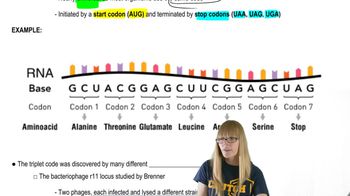Table of contents
- 1. Introduction to Genetics51m
- 2. Mendel's Laws of Inheritance3h 37m
- 3. Extensions to Mendelian Inheritance2h 41m
- 4. Genetic Mapping and Linkage2h 28m
- 5. Genetics of Bacteria and Viruses1h 21m
- 6. Chromosomal Variation1h 48m
- 7. DNA and Chromosome Structure56m
- 8. DNA Replication1h 10m
- 9. Mitosis and Meiosis1h 34m
- 10. Transcription1h 0m
- 11. Translation58m
- 12. Gene Regulation in Prokaryotes1h 19m
- 13. Gene Regulation in Eukaryotes44m
- 14. Genetic Control of Development44m
- 15. Genomes and Genomics1h 50m
- 16. Transposable Elements47m
- 17. Mutation, Repair, and Recombination1h 6m
- 18. Molecular Genetic Tools19m
- 19. Cancer Genetics29m
- 20. Quantitative Genetics1h 26m
- 21. Population Genetics50m
- 22. Evolutionary Genetics29m
11. Translation
The Genetic Code
Problem 30e
Textbook Question
A DNA sequence encoding a five-amino acid polypeptide is given below.
...ACGGCAAGATCCCACCCTAATCAGACCGTACCATTCACCTCCT...
...TGCCGTTCTAGGGTGGGATTAGTCTGGCATGGTAAGTGGAGGA...
Locate the sequence encoding the five amino acids of the polypeptide, and identify the template and coding strands of DNA.
 Verified step by step guidance
Verified step by step guidance1
Identify the reading frame: Determine the reading frame by looking for a start codon (ATG) in the given DNA sequence.
Locate the coding sequence: Once the reading frame is established, identify the sequence of codons that encode the five amino acids.
Determine the coding strand: The coding strand (also known as the sense strand) is the DNA strand that has the same sequence as the mRNA, except that thymine (T) is replaced by uracil (U) in RNA.
Identify the template strand: The template strand (also known as the antisense strand) is the DNA strand that is complementary to the mRNA sequence.
Translate the sequence: Use the genetic code to translate the identified coding sequence into the corresponding amino acids of the polypeptide.
 Verified video answer for a similar problem:
Verified video answer for a similar problem:This video solution was recommended by our tutors as helpful for the problem above
Video duration:
3mPlay a video:
Was this helpful?
Key Concepts
Here are the essential concepts you must grasp in order to answer the question correctly.
DNA Structure and Function
DNA is composed of two strands forming a double helix, with each strand made up of nucleotides. Each nucleotide consists of a sugar, a phosphate group, and a nitrogenous base (adenine, thymine, cytosine, or guanine). The sequence of these bases encodes genetic information, including the instructions for synthesizing proteins, which are made up of amino acids.
Recommended video:
Guided course

DNA Structure
Transcription and Translation
Transcription is the process by which the DNA sequence of a gene is copied into messenger RNA (mRNA). This mRNA then undergoes translation, where ribosomes read the mRNA sequence in sets of three nucleotides (codons) to assemble the corresponding amino acids into a polypeptide chain. Understanding these processes is crucial for locating the specific sequence that encodes a polypeptide.
Recommended video:
Guided course

Translation initiation
Template and Coding Strands
In DNA, the template strand is the strand that is read by RNA polymerase during transcription to synthesize mRNA, while the coding strand has the same sequence as the mRNA (except for thymine being replaced by uracil). Identifying these strands is essential for determining the correct sequence that encodes the desired polypeptide, as it directly influences the resulting amino acid sequence.
Recommended video:
Guided course

The Genetic Code

 11:43m
11:43mWatch next
Master The Genetic Code with a bite sized video explanation from Kylia Goodner
Start learningRelated Videos
Related Practice

